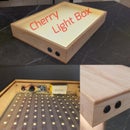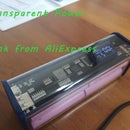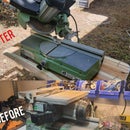Introduction: Mini Washer for Workout Clothes
This one bothered me for a while... No more.
@medanilevin on IG
Morning run is the best way to start your day!
Return home before anyone wakes up.
Happy, energized, dripping with sweat and ready to storm your day!
There's one obstacle though - the pile of the smelly-biological weapon grade-soaked running clothes.
What do you do with it?
I used to put it in the laundry basket and wait for the basket to fill up before running a load.
It was disgusting.
The smell permeated through the laundry and made it "inconvenient" in the small apartment.
And it's no good for you and your clothes.
Following is my solution for this, I hope you like it and build your own.
This instructable is a result of ~month of work which is summarized here:
https://dosimplecarbon.com/dosimplecarbon-small-wa...
https://dosimplecarbon.com/dosimplecarbon-small-wa...
Step 1: Doodling and Modeling the Idea
The idea was to have a small tank with water and detergent that will tumble the clothes in it.
So I started doodling. It works for me, try it for yourself!
What would be the features of the newly created solution?
What are the details which are important to you?
This was not an exception, and all started here.
The CAD modeling which followed was simply a step towards making the doodles a reality.
Step 2: What You Will Need?
First, print the models - Thing: 3216671
Two pieces of each: upper_base.stl and main_base.stl.
All the other pieces are one of each.
1. Plywood base or other scrap wood that you might have.
2. Magnets x 8: ebay (handle with care, these are strong)
3. Skate bearings x 4: banggood, ebay
4. 8mm dia. rod. I used carbon fiber tube I had lying around, but any 8mm diameter rod will do
5. Geared 12v motor 1:300 reduction, or something around this. banggood, ebay
6. DC-DC voltage step down: banggood, ebay
7. 10k potentiometer: banggood, ebay
8. On-off switch: banggood, ebay
9. Home Depot 2gal bucket+lid
10. Old laptop power supply 12-19v, this or this will be great (if you don't have one around).
11. 1/4"x3/4" bolts x 4.
12. Wood screws and several pieces of wire.
_________________________________________
Basic tools: screwdrivers, saw (for the wood base).
Hot glue gun + hot glue
CA glue
Soldering iron
Step 3: Assemble the Upper Base
Once you have printed the two pieces of upper base, you can stack them together (it is actually the same exact pieceX2).
Insert the bearings, you might need to push a little to make them go in.
Use your 8mm rod and slide it through the two pieces (see picture) this will align the two units so the base will rotate freely in the future.
Determine the width of the base according to the bucket that you have.
For the 2gal. bucket that I recommend they should be almost touching one another.
Use CA glue or hot glue and glue the pieces together. Make sure the rod is rotating freely all through the process.
Clamp and make sure the glue cures.
Step 4: Add the Main Bases
Now it's time to complete the lower base.
Print the parts.
Push in the bearings, as before you might need to push a little bit for them to go through.
Slide through the 8mm rod in the main bases and the previously assembled upper base.
Take your wooden base and using wood screws attach one base side.
Make sure there is a 2-5mm gap from each side and attach the second base to the wooden base.
Now you should have a rotating frame with a see-saw motion.
Step 5: Add the Magnets and Make It Move
This is the step when you will be cursing me a lot :)
Sorry, I did the same with mine (the cursing stuff)
Take you pile of magnets (8 total) and mark the same pole on all of them.
For example - the upper facing side.
This is important, make sure the marks are clearly visible and permanent.
Take the upper frame out (by sliding out the 8mm rod) and put it at a safe distance from the wooden base.
ONE by ONE glue in the magnets in the designated spots (the little squares in the printed parts)
Use CA and hot glue to secure them. Make sure the glue cures for each before adding another.
Glue them in such a way as to always see the marking you did.
The idea is: when everything is glued and assembled the same poles should face each other.
CAREFULLY - return the upper base to the wooden base and slide in the rod.
This is the outcome that you should get at this stage:
https://www.instagram.com/p/BoPMTgtHP7f/
These magnets are strong! and will easily jump around towards their buddy.
This is the reason to one-by-one action.
Step 6: A Few Words About the Bucket
I started with low rectangular box instead of the final 2gal bucket.
https://www.instagram.com/p/BoxD1d9nLLJ/
It was a mistake - it's not tall enough and spills the water all around (the pictures capture this).
Learn from my mistakes and use the bucket.
Step 7: Attach the Bucket and the Motor
The bucket is secured to the upper base with hot glue.
I was concerned at first, but now I can tell you it's fine, holds perfectly well with no snapping off.
Print the: motor_base and motor_clamp files.
Secure the motor base under the upper frame so that the exit shaft will align with the edge of the frame
The motor clamp piece is held by 4 1/4" bolts that go into the base.
Step 8: Connect the Mechanics
Glue the link_clip to the upper base
Slide in the motor_wheel into the shaft.
Connect between them with the printed link.
Step 9: Finish With Electronics
We have everything in place.
Now it's time to power it up.
https://www.instagram.com/p/BpXY-HFH-QG/
Print the electronics_box and make sure you can attach it to one of the main bases.
We'll modify the voltage step down unit a little bit.
Take the unit and solder out the blue potentiometer box.
Take you bigger 10k potentiometer and solder it in to the same 3 spots with some spare wire.
Now the final assembly:
Route the cord from your power supply to the "in" leads of the voltage regulator (through a switch)
Connect the "out" tabs to the motor leads.
Make sure everything works.
Close the box.
Your washer is ready!
Step 10: Epilogue
My morning routine changed a little bit with this unit completed.
After the shower, I take ~10 min to wash the clothes and hang them out to dry.
The wash is gentle and removes the odors perfectly well.
Because the clothes are isolated from the full washer, I can experiment with all kinds of smell removers.
The vinegar works btw!
I hope you enjoyed this.
I wish you happy running and clean clothes,
Dani
Follow me on IG: @medanilevin
And subscribe to our mailing list on dosimplecarbon.com













